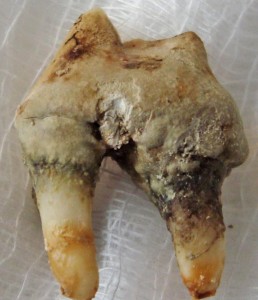
Did you brush your teeth today? If not, how does everyone else around you feel about it? As with people, not brushing a dog’s teeth can have some rather negative repercussions in the areas of bad breath and oral disease.
The buildup of plaque, (the chalky bacterial material that sticks to teeth), seems to be a primary culprit in oral disease. Plaque, once deposited on the teeth, will begin to calcify in a couple of days. This buildup of calcium is called calculi. The calculi trap food and other debris along the gum line. The gums response is inflammation, (gingivitis). The inflammation will cause the gums to regress and expose the tooth root that will lead to deeper infections of the bone or loss of the tooth.
Dogs can have varying degrees of problems with their teeth. Some breeds are more prone to having food buildup in the cheek areas that in turn feed the oral plaque. Also, the food left in the mouth will start to rot causing that ever so fragrant ‘swamp mouth’ smell. Conformation of the face, frequent feeding, and chewing behavior can all affect the amt of food left in the mouth after a meal.
Ideally, we should be brushing our dog’s teeth twice daily but once daily in the evening will give you great benefits. Reality…if we can brush them at least three times per week to keep the plaque from calcifying we can also prevent a large amt of dental problems.
Brushing teeth:
Step one: Purchase a long handle, preferable curved, toothbrush for dogs. Finger toothbrushes (thimble looking) are also great if you don’t mind sticking your finger in the dog’s mouth.
Step two: Toothpaste can be purchased for dogs. Do not use anything with fluoride in it. Since dogs are not prone to spitting after brushing they tend to swallow more fluoride than is safe. Your can find pastes have a meat or peanut butter flavor that will reinforce to your pet that brushing is both fun and yummy. Enzymatic toothpastes are usually recommended
Step three: Brush those chompers. Initially, your dog may not like to have a toothbrush inserted in to their mouth. Young dogs are usually easier to start with. Sometimes you have to use a piece of gauze or cloth until they are familiar with tooth brushing. Start with just cleaning the front teeth until your dog accepts your efforts. Focus most of your attention when cleaning towards the teeth in contact with the cheek. The largest portions of problems are usually focused in this area. If you have trouble cleaning the inside part of the teeth it is OK. The body has a built in toothbrush called the tongue. The amt of plaque buildup on the tongue side is usually markedly less than the cheek side due to the increased contact with the tongue. Try, but do not feel bad if you dog never allows you to clean this area.
The toothbrush should be placed in the mouth on a 45 degree angle to the gums to reach under the gingiva a little. Soft bristles and a gentle oval brushing pattern will help to
optimize the cleaning.
For dogs that do not allow for oral brushing, there are a couple of other options. Oral rinses are available that can be used as a mouthwash to decrease bacterial load in the mouth. Even a water rinse of the cheek pouches with a sport bottle can decrease food residues in the mouth. Dental sealants can be used on a weekly basis and are easy to apply and can be purchased from your veterinarian.
In closing, home dental care will reap rewards far greater than sweet smelling breath. You will also be protecting your pooch from potentially life threatening problems like kidney and heart disease. So keep those teeth brushed!

